
Darwin is the capital city of the Northern Territory, Australia. With a 2019 estimated population of 147,255, it has more residents than the rest of the sparsely populated Northern Territory. It is the smallest, wettest, and most northerly of the Australian capital cities and serves as the Top End's regional centre.

The Northern Territory is an Australian territory in the central and central northern regions of Australia. It shares borders with Western Australia to the west, South Australia to the south, and Queensland to the east. To the north, the territory looks out to the Timor Sea, the Arafura Sea and the Gulf of Carpentaria, including Western New Guinea and other islands of the Indonesian archipelago.

The Northern Territory Police Force is the police body that has legal jurisdiction over the Northern Territory of Australia. This police service has 1,537 police members made up of 79 senior sergeants, 228 sergeants, 839 constables, 208 auxiliaries, and 73 Aboriginal Community Police Officers. The rest of the positions are members of commissioned rank and inoperative positions. It also has a civilian staff working across the NT Police, Fire and Emergency Services.

Between February 1942 and November 1943, during the Pacific War of World War II, the Australian mainland, domestic airspace, offshore islands and coastal shipping were attacked at least 111 times by aircraft from the Imperial Japanese Navy Air Force and Imperial Japanese Army Air Force. These attacks came in various forms; from large-scale raids by medium bombers, to torpedo attacks on ships, and to strafing runs by fighters.

The Bombing of Darwin, also known as the Battle of Darwin, on 19 February 1942 was the largest single attack ever mounted by a foreign power on Australia. On that day, 242 Japanese aircraft, in two separate raids, attacked the town, ships in Darwin's harbour and the town's two airfields in an attempt to prevent the Allies from using them as bases to contest the invasion of Timor and Java during World War II.
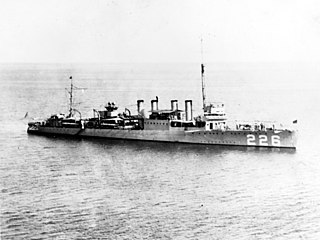
USS Peary (DD-226) was a Clemson-class destroyer of the United States Navy. She was commissioned in 1920 and sunk by Japanese aircraft at Darwin, Northern Territory, Australia, on 19 February 1942.

Adelaide River is a small but historically significant town located at the crossing of the Stuart Highway over the Adelaide River in the Northern Territory of Australia. The town is upstream of the Adelaide and Mary River Floodplains Important Bird Area. At the 2016 census, Adelaide River had a population of 353. Adelaide River is part of the Coomalie Shire and is the second largest settlement in the local government area.

RAAF Base Darwin is a Royal Australian Air Force (RAAF) military air base located in the city of Darwin, in the Northern Territory, Australia. The base shares its runway with Darwin International Airport, for civil aviation purposes. The heritage-listed RAAF Base Darwin is a forward operating base with year-round activity with approximately 400 personnel.

Crime in the Northern Territory is managed by the Northern Territory Police, the territory government's Department of the Attorney-General and Justice and Territory Families.
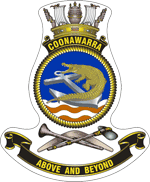
HMAS Coonawarra is a Royal Australian Navy (RAN) base located in Darwin, Northern Territory, and is home to twelve fleet units of the RAN. The current commander is Commander Darren Rushworth, RAN.
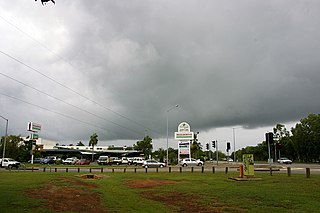
Leanyer is a northern suburb of Darwin, in the Northern Territory of Australia.
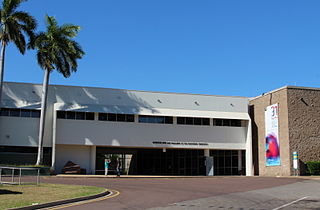
The Museum and Art Gallery of the Northern Territory (MAGNT) is the main museum in the Northern Territory. The museum is located in the inner Darwin suburb of Fannie Bay. The MAGNT is governed by the Board of the Museum and Art Gallery of the Northern Territory and is supported by the Museums and Art Galleries of the Northern Territory Foundation. Each year the MAGNT presents both internally developed exhibitions and travelling exhibitions from around Australia. It is also the home of the annual Telstra National Aboriginal and Torres Strait Islander Art Award, Australia's longest running Indigenous art prize.
Dr Thomas Anthony Lewis, OAM is an Australian author, military historian, editor, teacher, and former naval officer. An author since 1989, Lewis worked as a high school teacher, and served as naval officer for 20 years, seeing active service in Baghdad during the Iraq war, and working in East Timor. In June 2003, Lewis was awarded the Medal of the Order of Australia for meritorious service to the Royal Australian Navy, particularly in the promotion of Australian naval history.

Hughes Airfield is an airfield in the Northern Territory of Australia located in the locality of Hughes. It was constructed during World War II for military use. The airfield now functions as a base for aerial firefighting aircraft to protect the outer rural suburbs of Darwin.

The Darwin rebellion of 17 December 1918 was the culmination of unrest in the Australian Workers' Union which had existed between 1911 and early 1919. Led by Harold Nelson, up to 1000 demonstrators marched on Government House at Liberty Square in Darwin, Northern Territory, Australia where they burnt an effigy of the Administrator of the Northern Territory, John Gilruth, and demanded his resignation.

The Victoria Hotel, or The Vic as it is commonly known, is a heritage listed pub located in Darwin, Northern Territory, Australia. Built in 1890, it is an important historical building but is currently closed.
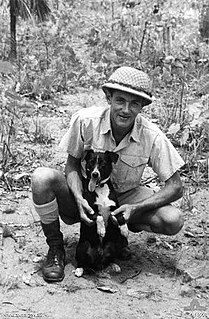
Gunner was a male kelpie dog who became notable for his reliability to accurately alert Allied air force personnel that Japanese military aircraft were approaching Darwin during the Second World War.
The Darwin Festival celebrates the multicultural aspects of the Northern Territory lifestyle. The Festival is held over 18 days in the dry season (May-Oct) and comprises a series of events including outdoor concerts, workshops, theatre, dance music, comedy, cabaret, film and visual arts. Come 2021, Darwin Festival will be held from 05–22 August, subject to cancellation caused by COVID-19 pandemic.
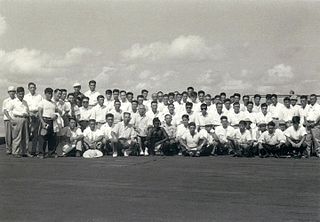
The Fujita salvage operation was a two-year marine salvage operation of World War II shipwrecks in Darwin Harbour in the Northern Territory of Australia from 1959 to 1961.

Darwin 1942: The Japanese Attack on Australia is a 2017 book by Bob Alford, illustrated by Jim Laurier. It covers the two air raids on Darwin in the Northern Territory in Australia on February 19, 1942. It is considered to be a recent publication on World War II The bombing of Darwin was often called ‘Australia’s Pearl Harbour’, the bombing of Darwin by aircraft of the Imperial Japanese Navy began on 19 February 1942, killing more than 230 people and destroying ships, buildings and infrastructure.



















